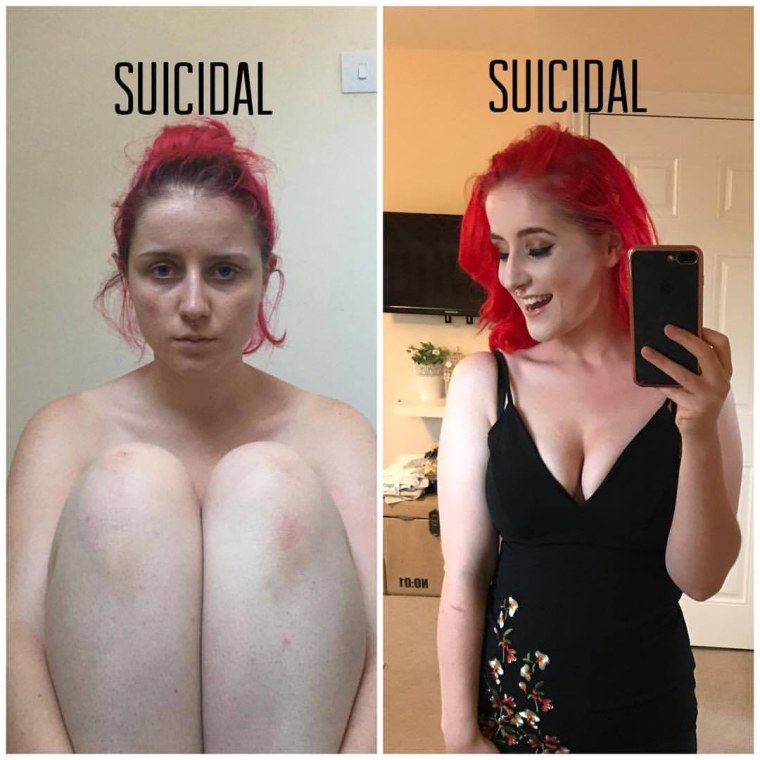This story discusses suicide. If you or someone you know is at risk of suicide please call the U.S. National Suicide Prevention Lifeline at 800-273-8255, text TALK to 741741 or go to SpeakingOfSuicide.com/resources for more additional resources.
When Milly Smith was a teen, she went to a doctor and admitted she thought about killing herself. But the doctor dismissed her by saying Smith didn’t “look suicidal.”
“It took a ton of courage to go there and I was in a very vulnerable state,” Smith, 25, of Hull, England, told TODAY via email. “I was crushed and felt invalidated and alone.”
As she struggled with her mental health over the next decade, that comment stuck with her. Smith has been sharing her experiences on social media and last year she posted a photo of herself with a huge grin on her face. But the message she included with it revealed there was more to the picture.
“This photo was taken just 7 hours before I tried to take my own life for the 3rd time. This photo was taken in the morning … That evening I took an overdose that left me in the hospital for a week,” she wrote. “I had no idea I’d try to take my own life in the morning. I was smiling and loved the way my hair looked hence the selfie.”
Smith decided to divulge the story because she hoped to help people better understand that suicide doesn’t have a look. Her message has gone viral.
“I wanted to break the stigma,” she said. “Suicidal tendencies are still such a taboo and I wanted people to know they can talk about it, that it’s not to be ashamed of and they’re not alone.”
Experts agree appearance isn't always an accurate predictor of mental health.
"There isn’t a look per se. There are lots of people who feel a lot worse than they appear," said Dr. David A. Brent, professor of psychiatry at the University of Pittsburgh.
Like "Saturday Night Live" actor Pete Davidson, Smith has borderline personality disorder (BPD), a condition that makes it hard for people to regulate their emotions. The National Alliance on Mental Illness estimates 1.6 percent of adults in the United States have BPD. People with the disorder experience mood swings, impulsivity, conflicted personal relationships and poor self-esteem. Many people with BPD engage in self-harm behavior and attempt suicide.

Smith’s story illustrates the challenges associated with predicting and preventing suicide.
“It is hard to predict if someone is going to die by suicide,” said Jessica Ribeiro, an assistant professor of psychology at Florida State University, who studies how to determine suicide risk.
While Ribeiro uses machine learning algorithms to predict suicidal behavior more accurately, she said there are some symptoms that point to an increased likelihood of dying by suicide. People with a history of self-harm or suicide attempts are more likely to die by suicide, for example.
“Depression is something that is often referenced as a risk factor for suicide. Ninety-six percent of the time, people with depression don’t kill themselves,” she said.
Suicidal people don’t always act or look sad, as Smith’s story indicates, and this adds to more misunderstandings about mental health. Chester Bennington, the lead singer of Linkin Park, killed himself in July 2017. Month later, his wife, Talinda, posted a video of him laughing 36 hours before he took his own life.
“It can seem very confusing that individuals both have reasons to live and reasons to die,” said Ribeiro. “There is a lot of ambivalence.”
Brent said some people might seem happy or less burdened after deciding to kill themselves, but experts do know they are struggling prior to the attempt.
"Some people, when they make the decision to kill themselves, experience some release," he said. "I don’t know how common it is."
That's because there isn’t a lot of research on what people think or experience prior to committing suicide, Ribeiro said. But survivors have reported their loved ones made future-plans or seemed happy prior to killing themselves.
“The nature of suicide is so complex and there are so many variables in play,” she said.

In the year since her viral post, Smith's physical and mental health has had some ups and downs. But she continues to share her experience with BPD on social media to educate others and reduce the stigma.
"I hope people realize that it is not embarrassing or shameful to feel low, be in a bad place or need help. It's normal," she said.
But she also wants people to seek help before they're in crisis.
"You do not need to be at your lowest to ask for help," she said.
Smith sees a therapist and takes medication. She hopes her story helps other people realize mental illness is complex.
“Depression and suicidal tendencies will differ from person to person,” Smith said. “The stigma is a problem because it leaves people feeling they are not worthy of help if they don’t fit that ‘look.’”